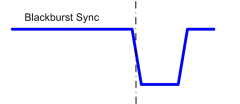
Video devices that are interconnected to each other must be synchronized with each other. Without synchronization no smooth transition from one source to the other is possible. The parts of a standard composite video signal that must be synchronized are: vertical, horizontal, frame, and color synchronization. In broadcast technology a fifth function is needed, the 'field one' reference. The signal that includes all of these parts is the 'blackburst' signal. A genlock master (house sync) is used and all devices are connected to this master (as slaves).
Blackburst is a blank composite color video signal with no picture data, just black. The horizontal (H) and vertical (V) synchronization pulses on a black burst ensure that all involved video signals 'begin' at the top left corner of the video screen at the same time. From there the video signals draw the video field in unison, all sources are at the same scan line at the same time. A switching between sources can flawlessly be made without any visible interruption.
It uses two voltage stages 0 volts and -0.3 volts. The trigger point is the negative leading edge of the signal.

For HD video tri level synchronization is used. It consists of a three-level sync pulse: blank: 0 volts, negative pulse -0.3 volts, positive pulse +0.3 volts, followed by the video image data. Tri-sync provides sync for the 3 component signals of the YCbCr HD signal. The tri level sync is positioned within the horizontal blanking interval.
The White Reference Level is set at 0.7 volts and drops to 0 volts at the start of the blanking period. After that the signal drops to -0.3 volts, raises to +0.3 volts and goes back to 0 volts.

Todays sync generators normally supply blackburst and tri level sync at the same time out of different generator outputs.
Typical TriLevel sync signals:
TriLevel 720p25
TriLevel 1080p29.97
TriLevel 720p24
TriLevel 1080p25
TriLevel 720p60
TriLevel 720p23.98
TriLevel 1080p24
TriLevel 720p59.94
TriLevel 1080i60
TriLevel 1080p23.98
TriLevel 720p50
TriLevel 1080i59.94
TriLevel 720p30
TriLevel 1080i50
TriLevel 720p29.97
TriLevel 1080p30